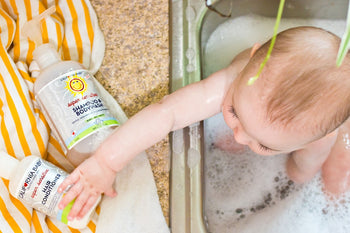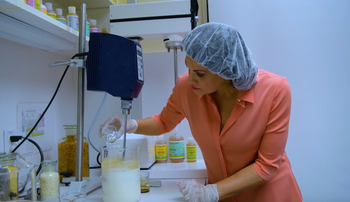Being a newborn is tough work. They can’t hold up their heads; their stomachs are trying to digest for the very first time; they can only see a whole 12 inches in front of them and, to top it off, all they can do is cry when they need a diaper change. While muscle strength, digestion and vision sort themselves out, perfecting the art of diaper duty falls to us. Taking off your baby’s diaper and confronting a rash-ridden bum sends even veteran parents scouring the shelves for anything that might help.

Before you throw everything in your medicine cabinet on a newly discovered diaper rash, knowing what kind of rash you’re dealing with and what caused it will help you make a better decision on the best diaper rash cream for the job. At California Baby, we’ve been through the rounds with diaper care. Here’s what you need to know to treat and prevent diaper rash.
Different types of diaper rash
First things first, not all diaper rash is the same. Let’s get up to speed on the different kinds of diaper rashes so you can spend less time trying to find the best diaper rash cream and more time sleeping.
Contact Dermatitis
Contact Dermatitis occurs when your baby’s skin comes in contact with harsh chemicals, allergens or simply chafing. This rash appears as patches of dry, red and irritated skin in areas of contact and friction.
Yeast Infections
A fungal diaper rash caused by an imbalance of microbes on the skin or in the gut (usually spurred on by diet change, infrequent diaper changes or antibiotics) can feel hot to the touch and looks red, moist and sometimes blister-like sores that typically originate in dark, wet places like skin creases.
Intertrigo
This is inflamed skin caused by skin-on-skin friction, usually in skin folds. This type of rash can eventually lead to a fungal or bacterial rash if not treated.
Eczema
Although not as common in the diaper area, eczema can show up there as dry, itchy and sometimes scaly patches. This inflammatory response is usually sparked by an environmental trigger such as diet or allergens.
What causes diaper rash?
Newborn’s skin is highly sensitive to just about everything in this big new world outside the womb and can react to changes in diet, medication (theirs or mom’s), the very skincare products meant to help or even the diaper itself. The age-old saying “never wake a sleeping baby” needs a modern-day caveat because, even in our era of ultra-absorbent diapers, newborns need to be woken up for frequent diaper changes to keep the diaper area clean and dry.
Pro parent tip:
When you see “ultra-absorbent” diapers in the diaper aisle you may see the possibility for some more Z’s, but proceed with caution. Diaper companies are not obliged to disclose ingredient or material lists to parents, and the skin safety of ultra-absorbent chemicals is still a big question mark. What we do know is that when a baby's skin is rubbing against any type of wet diaper for prolonged periods of time, it can cause skin irritation and vulnerability, creating a more susceptible environment for microorganisms like bacteria and fungi to breach.
Depending on their raw ingredient selection and purification process, baby products — from wipes to baby powder, lotion to diaper rash cream or ointment — may contain contaminants or preservatives that can cause a skin reaction or intensify an existing condition. Using skincare products with ingredients like talc, synthetic fragrances, sulfates, parabens, petrochemicals and phthalates can make already unhappy skin worse, especially if your baby has sensitive skin and is prone to frequent diaper rashes.
Changes in baby’s diet, and if breastfeeding, changes in mom’s diet as well, may also cause a diaper rash. What your little one eats affects their gut microbiome and consequentially the yeasts and bacteria that end up in their diaper. It may sound like a scene from a western movie, but when these moisture-loving microorganisms from your baby’s stomach sit in a wet diaper for too long, they have a stand-off with the microorganisms that naturally thrive on dry skin. When we don’t dry the skin fast enough, we create the perfect environment for the moisture-loving microorganisms to take over and fungal diaper rash to thrive. Antibiotics (again, taken by baby or mom) also alter the gut microbiome and can lead to a similar outcome.
Diaper rash treatment and prevention
Rule number one after you find out your baby has a diaper rash: Pause. Take a deep breath. You are doing great. A little investigative work can go a long way to help you treat diaper rash more effectively — like keeping a food diary to determine if your baby’s diaper rashes are diet-related. If it surfaces during a transition from wet to solid foods or with the introduction of a new food item, take a step back and reintroduce that food more slowly or at a later time. Diaper rashes caused by a change in the gut microbiome due to diet or antibiotics are fungal in nature and need to be kept as dry as possible.
The products you use (and how often) can have a big impact on skin sensitivity. Cleaning the area with a gentle cleanser (keep scrolling for info on our plant-based Diaper Area Wash) is a good place to start, but make sure your product of choice isn’t hiding any skin-irritating ingredients like synthetic fragrance. Many diaper wipes contain harsh cleansing ingredients that can actually promote diaper rash and there have been many cases of wipes being recalled for mold and bacterial growth. Be mindful that over wiping will exacerbate already raw skin, so if you need to wipe the area immediately, use a soft cloth, like our reusable Organic Cotton Wipes, with a gentle wash or plain water. Giving your little one a short, warm bath is also an effective way to sanitize without needing to wipe the area.
After gently cleansing, gently pat the area dry before applying any diaper rash cream. A talc-free baby powder (we’ve got your back here, too) will soak up excess moisture and can help dry out a damp rash. Double-check that your powder does not contain talc, which can cause micro abrasions in the skin and is harmful to breathe in. If your floor is due for a mopping anyway, let that squishy bottom air out by allowing your baby to go diaper-free. If you need to put a diaper on your little one, try a loosely applied cloth diaper (washed with hypoallergenic laundry detergent) or a fragrance-free, hypoallergenic disposable diaper to ensure airflow.
It's important to change diapers regularly both during a diaper rash outbreak and to prevent new ones. If there is a rash present, protect your baby’s bottom by applying a nourishing diaper rash cream. Our bio-based Diaper Rash Ointment is a parent favorite for good reason - it treats diaper rashes and if you apply an even layer with most diaper changes it can help prevent diaper rashes from happening in the first place. When possible, we always recommend using plant-based products on your little one’s delicate skin to treat and prevent diaper rashes triggered by allergens or harsh ingredients.
Jessica’s 3-step system to treat and prevent diaper rashes (featuring all plant-based diaper products)
-
Diaper Area Wash + Organic Cotton Wipes
Our Diaper Area Wash along with California Baby Organic Cotton Wipes is Jessica’s solution to the potential problems that disposable wipes present. Besides being an environmental nightmare, wet wipes are just a lot of water with preservatives and fragrance, both of which can cause irritation.
Our diaper area wash makes cleaning up diaper messes super easy. It’s powered by plant-derived cleansers like witch hazel and soap bark with soothing calendula (from California Baby’s own certified organic calendula farm) and aloe vera. Organic soap bark breaks down excess oils so there’s no need for skin-agitating surfactants. Our cleanser is free of synthetic fragrances and is mild enough to use at every diaper change.
Spray the Diaper Area Wash directly onto your baby’s bottom or onto our Organic Cotton Wipes (made with organic Egyptian cotton without chlorine, bleach or chemical softeners) and gently wipe it off. If there is a burning rash present, you can spray it directly onto the baby's bottom and let it dry without wiping. In the case of a hardened #2, spray on the cleanser to loosen things up so you can clean more easily and without scrubbing.

-
Soak up excess moisture with Organic (Non-Talc) Powder
After cleaning with the Diaper Area Wash or after a bath, use our Organic (Non-Talc) Powder to ensure there is no wetness remaining that can get trapped in their diaper. Our powder contains no talc and instead uses corn starch, tapioca starch and kaolin clay to absorb moisture. Pure essential oils like French lavender, tea tree and clary sage to provide a fresh, calming scent
-
Diaper Rash Ointment
Jessica's final step to rash-free skin is our lavender-scented Diaper Rash Ointment (also available fragrance-free) that contains vitamin-grade zinc oxide, soothing licorice, moisturizing coconut oil and ultra-purified lanolin from sheep's wool. These ingredients work together to calm irritated skin while creating a barrier that sits on top of the skin between your little one’s sensitive areas and rash-inducing moisture.
A preservative-free concentrated formula without added water, our ointment is 100% USDA Certified Bio-Based (excluding zinc in the mineral category) so you can feel safe about putting it on delicate skin. Evenly spread a thin layer of the diaper rash ointment in the diaper area once the skin is clean and dry to create a barrier against moisture.
Not only are our diaper rash products full of plant-powered goodness, but they’re made in California Baby’s solar-powered, FDA-registered and certified organic facility to eliminate cross-contamination with common allergens. We keep environmental impact top of mind with sustainably sourced ingredients because we know that quality is non-negotiable for your little one’s health and for the health of the world they will grow up in.
What does bio-based mean?

Biobased products are derived from plants and other renewable agricultural, marine, and forestry materials. Biobased products provide an alternative to conventional petroleum derived products.
When you buy a certified 100% bio-based product you know that the product is free of petroleum-based synthetic ingredients. Our bio-based products are sent to an independent lab to be carbon-14 tested, where they identify the percentage of carbon that comes from plant or animal sources versus petrochemical sources. Then they grade the product based on those results. The results are then sent directly to the USDA, not to us. We are proud to wear our 100% Certified Bio-Based symbol on our diaper rash ointments so you know exactly what you are getting without having to look up every ingredient on the label.
Let’s talk lanolin
Pharmaceutical-grade lanolin is the ingredient in our Diaper Rash Ointment that gives it its moisture-repelling superpowers, sealing off the diaper area skin and shielding it from further damage. Lanolin is a sturdy, wax-like alternative to petroleum or fish oil, retrieved by pressing the wool of a sheep (Sheep are not harmed in the process). Although lanolin isn’t new to diaper rash cream, not all lanolin is created equal. If a company uses lanolin from sheep whose wool has been sprayed with pesticides, those pesticides will turn up in the end product. Pesticides are toxic chemicals and if they end up on your baby’s skin they can cause skin irritation, and further, when they are soaked into the body continuously they present the possibility of long-term, serious health issues (pesticides have even been found in breast milk!). California Baby uses only ultra-purified lanolin from suppliers who actively test for and remove contaminants to make sure they don’t end up in our products.
The best approach to diaper rash? Stay calm.
Your baby’s first diaper rash can feel like an alarming event. But like the amazing parent you are, you’ve equipped yourself with the knowledge you need to best help your little one. Keep calm, carry on and do your best to sort out the underlying causes of the rash before throwing everything you’ve got at it. Remember: You’ve got this, and we’ve got your back when it’s time to level-up diaper duty.

DISCLAIMER: The information contained herein should NOT be used as a substitute for the advice of an appropriately qualified and licensed physician or other health care provider. The information provided here is for informational purposes only.
















